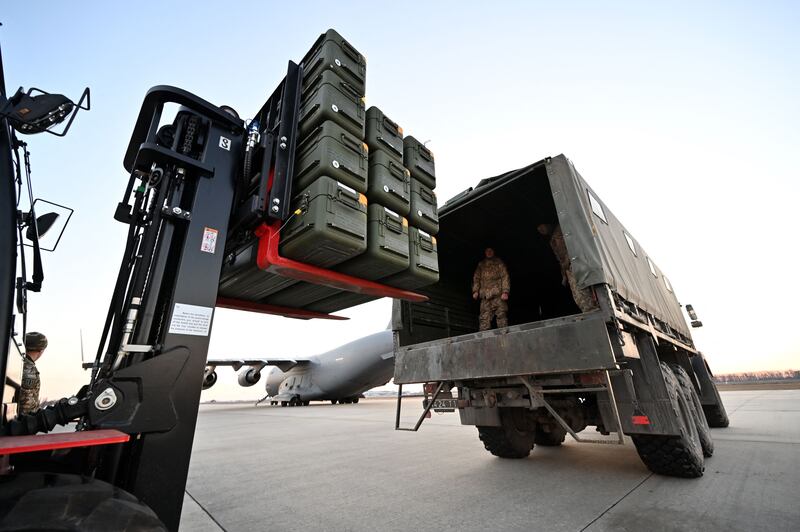In May, when Washington ordered 1,300 Stinger anti-air missiles to replace those sent to Ukraine, the chief executive of Raytheon, the defence company that makes them, replied: “It’s going to take us a little bit of time.”
Paris, meanwhile, has sent 18 Caesar howitzers to Kyiv — a quarter of its total stock of the high-tech artillery — but it will take French company Nexter about 18 months to make new ones.
The Ukraine war has exposed the skimpiness of western defence stockpiles — especially of unglamorous but crucial supplies such as artillery shells that have been the mainstay of fighting. Lack of production capacity, labour shortages and supply chain snafus — especially computer chips — mean long lead times to replenish them.
The shortages, defence officials and analysts say, reveal the West’s complacency about potential threats since the end of the cold war, now shown up by the desire to shore up Ukraine with military support. Fetishes for high-tech weaponry and lean manufacturing have obscured the importance of maintaining stockpiles of basic kit, they add.
“Ukraine has been a lesson in how war is still often won through the classic elements of artillery, ground troops and occupation,” says Jamie Shea, a former Nato director of policy planning, now an associate fellow at Chatham House, a UK think tank. “The military balance which has swung from the old to the new needs to shift back.”
Those scarcities may now be impinging on the West’s ability to quartermaster Kyiv’s war effort. Total annual US production of 155mm artillery shells, for example, would last less than two weeks of combat in Ukraine, according to Alex Vershinin, a US procurement expert who says the conflict marks “the return of industrial warfare”.
“It’s like the first World War’s great shell crisis,” says Shea, recalling a 1915 scandal when massive artillery use in trench warfare depleted British stocks, a shortage that led to high troop casualties and the resignation of prime minister HH Asquith.
Ben Wallace, the UK’s defence minister, has said western countries would struggle to wage a protracted war comparable to Russia’s assault on Ukraine as their ammunition stocks “are inadequate for the threats we face”. During a simulated war game last year, the UK’s ammunition ran out after eight days.
[ Ukraine’s digital defences hold out in cyber war with Russian hackersOpens in new window ]
No one believes the West is about to exhaust its basic weaponry by supplying Ukraine. Officials say most of the equipment provided to Ukraine remains available or can be swapped out for similar systems. Russia’s defence budget last year of $66 billion (€65.2bn), even when combined with China’s $293 billion of spending, is dwarfed by Nato members’ combined budget of over $1.1 trillion.
Even so, a large part of that Nato spending has been on advanced systems, such as fighter jets, that have not been deployed by the West in this conflict. Much of western defence over the past 20 years has been geared towards fighting counter-insurgencies in the Middle East rather than being ready for heavyweight tank and artillery battles such as those in Ukraine.
Compounding the supply problems has been a decades-long emphasis on lean manufacturing, financial efficiency and industrial consolidation, which has worked against military planners keen to maintain costly weapons inventories.
In the UK, low stockpiles meant it recently had to buy howitzers from a third party to send to Ukraine, reportedly a private Belgian dealer. In the US, the Pentagon works with just five main defence contractors; in the 1990s, the number was 51.
“The received wisdom has long been that the West will never fight an industrial war again,” says one western defence adviser. “As a result, almost nobody has kept up capacity to ramp up national production of key equipment.”

Western arms manufacturers are scrambling to secure supplies of scarce components and materials to make weapons and munitions that, until recently, were barely in demand. Some of the electronic components of Stinger missiles, last manufactured at scale 20 years ago, are no longer commercially available, according to Raytheon.
Alex Cresswell, chief executive of Thales UK, which makes the anti-tank NLAW missiles lauded in Ukraine, says the “UK has been running down [defence] stockpiles but not investing sufficiently enough to avoid obsolesce.”
As for the guided multiple-launch rocket systems made by Lockheed Martin that Kyiv has pleaded for so it can launch strikes behind enemy lines, the US has dispatched about a third of its total stock of 20,000-25,000 missiles.
But it cannot readily replace these with older versions because they use banned cluster weapons in their warheads, says Mark Cancian, a former Pentagon official now at the Center for Strategic and International Studies think tank.
Russia also suffers from supply problems, say officials and analysts. Defence manufacturer UralVagonZavod is reportedly running triple shifts to refurbish old tanks. Ammunition supplies are being partly replenished from a massive storage depot in Belarus.
But the recent appointment of Gen Gennady Zhidko, former vice-minister of defence, as overall commander of Russian forces in Ukraine gives the military “institutional firepower in Moscow ... so it has a powerful voice to make sure it gets the economy it needs”, says Mark Galeotti, a UK-based Russia expert.
Military experts have been scouring the Ukraine conflict for insights about the nature of modern war. Lesson “number one” so far is the importance of maintaining basic stockpiles, says Jack Watling, senior research fellow at the Royal United Services Institute think tank.
“This isn’t new, but it’s something we have been determined to ignore for a very long time,” Watling told a warfare podcast. “Cheap munitions that you can use at scale are absolutely critical ... [The West needs] to be much more disciplined about not always chasing the exquisite but instead understanding how the exquisite enables the fairly dull and mundane.”




















